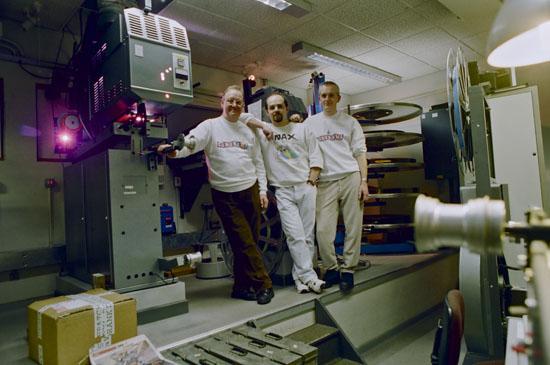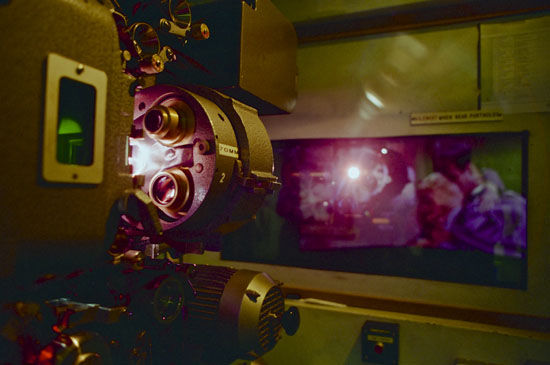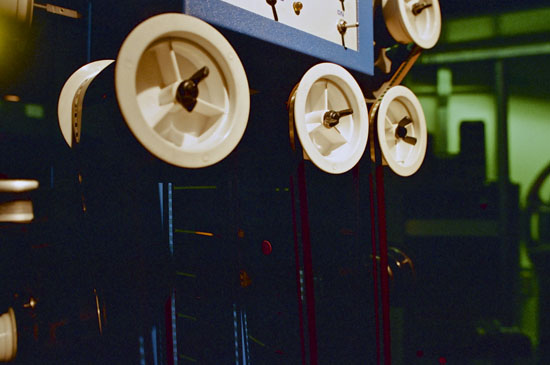|
| |
Projecting the Widescreen Weekend
Pictureville,
Bradford, England
|
This article first appeared in
..in 70mm
The 70mm Newsletter |
|
Article and pictures by:
Thomas Hauerslev |
Issue 54, Sept 1998 |
|
 Tony,
Juan
and Duncan Tony,
Juan
and Duncan
Here, projectionists Mr. Tony Cutts and Mr.
Duncan McGregor are discussing the 1998 Wide Screen Weekend at
Bradford's Pictureville
Cinema (England).
This
year's festival went much better than last year. Last year [1997] we had no time to
prepare the films, because the prints came very late and the scheduling during the weekend
was very tight. This year all prints came in time, except "Ryan's Daughter"
which arrived only hours before the screening. And we had a lot more
advance notice of what we were going to show.
Some 70mm prints are on site like "The Big Blue", "The
Last Valley", "The King and I" and "Custer of the West".
We had plenty of time to recover them and re-check them. It does take a lot of time to run
the Wide Screen Weekend. Giving credit where it is due, management realized a lot of the
problems we had last year. We have plenty of time this year and yes, we are quite happy.
Because of the re-building of the museum we were able to have two make-up tables. That
meant two projectionists at a time checking films. We can move faster, and that helps a
lot.
The old prints are not in the best condition
so we have to check everything. Just think of it. A Cinerama film is not only twice
as much work. It is 8 huge reels of film that have to be synchronized perfectly, just to
show one film! A lot of time goes into preparing a 3-strip movie performance. The
projectors have to be re-aligned for each format. Cinemiracle is different from Cinerama.
|
Further in 70mm reading:
• WSW Home
• Through the Years
• The Best of WSW
•
Academy of the WSW
•
Creating the WSW
•
Planning the WSW
• Projecting
the WSW
•
Home of
CINERAMA
•
Projecting CINERAMA
Internet link:
|
|
 "Can
Can" in Todd-AO projected by Cinemeccanica "Can
Can" in Todd-AO projected by Cinemeccanica
Last
year we spent a considerable amount of time preparing "Windjammer" in
Cinemiracle, but we did not have time to line the projectors up before the show. That was
actually done during the show while presented it to the public! We did the alignment 3
weeks ago this year, and we are a lot happier about that. Nothing makes us feel worse than
a bad performance because we did not have time to check it. In 1996 Duncan and I spent
weeks preparing "How the West Was Won" for the festival, matching the
picture up with the sound.
After a perfect show the public was applauding madly and
telling us how brilliant we were. We were floating out of the projection room as two happy
projectionists. Last year with all those mistakes, we just felt like going home after the
show. It upsets the audience and it upsets us. The audience was not very happy, so what
went wrong? We did not have time to run it before the performance. Last year we were
actually checking part two of "How the West Was Won" while part one was
running in the projectors. It was a nightmare! Management is aware of the difficulties.
This year [1998] we have been given more time and it is paying off. The audience is happy
and we are happy, although we still have a lot to do with the Cineramacana show
tomorrow. That´s going to be very interesting. People are coming up to the booth to ask
about it.
Years
ago, back in Leeds at the Majestic, I used to get butterflies in my stomach just
before I started the projector whenever we had a new 70mm Todd-AO film. I got the same
feeling today, bringing the fader down, pushing the button and starting "Can
Can"! I have not seen the film since I was 19. It was the first 70mm I ever ran.
A very nice sensation.
We have a few problems with the prints. They
buckle both sideways and top/bottom which means that you cannot focus on the entire
screen. The frame is popping in the gate like a slide projector. Jennifer had a hard time
trying to keep "Ryan´s Daughter" in focus. Some of the older
prints are also faded, which means the green and blue colors are gone, leaving a pinkish
look. It is caused by the passage of time, unfortunately. Our own 70mm prints of "The
Last Valley" and "Custer of the West" are slightly pinkish but
otherwise in really good condition.
|
|
 Every
year I look forward to this weekend. We work from 9 am until 11 pm every day during the
Wide Screen Weekend. Those are long and very tiring days, but when everything is rolling
smoothly, you are running on the adrenalin. It is absolutely fantastic to run all these
old 70mm films. It is so nice to see people coming in from all over the world and enjoying
themselves. Compliments!, compliments!, compliments!, all the time. Every
year I look forward to this weekend. We work from 9 am until 11 pm every day during the
Wide Screen Weekend. Those are long and very tiring days, but when everything is rolling
smoothly, you are running on the adrenalin. It is absolutely fantastic to run all these
old 70mm films. It is so nice to see people coming in from all over the world and enjoying
themselves. Compliments!, compliments!, compliments!, all the time.
There is immense interest from the audience.
They want to know which projector does what and how Cinerama works. The general public
cannot get it into their heads how we can run 3 projectors at the same time without the
pictures getting out of sync. Many people comment on the image, how brilliant it is. They
want to know what kind of sound systems we have and we show them the processor. We have
Dolby Digital and SDDS. We have DTS 70mm on loan, but we hope to get it permanently. And
they usually comment on how splendid the sound is. Paul Gerber, director of several 70mm
short films, told us "Bill, you´ve got a fantastic sound system in this
theatre". It is very good to hear that from people inside the trade.
They
ask about the difference between the curved and flat screen. They are very keen to see
what happens on the different screens. Some films are made to be shown on the Cinerama
curve, and if it is well done, it looks good and develops a more 3-dimensional aspect. You
feel more drawn into the picture. They forget everything else because of the picture in
front of them. The audiences clearly prefer the curve to the flat screen. Generally, we
have a difficult job explaining the difference between the formats and what film goes on
which screen. "Why don't you show this on the curve?" they often ask.
New films are not filmed for curved screens and we show them on the flat screen. "Hamlet"
would have looked awful on the curve. A real close-up of somebody's head fits nicely on a
small multiplex screen, but getting it on THAT [motions towards the large deep-curve
screen,- ed], you would feel it a bit overpowering and you want to go away. Due to the
curve, a lot of the frame is cropped and you lose important information.
The audiences love the curve. 70mm and a big
screen has a great impact on them. They come to Pictureville to see it. It is unique and
they can't get it elsewhere.
|
|
Go: back
- top - back issues
Updated
22-01-25 |
|
|

 Tony,
Juan
and Duncan
Tony,
Juan
and Duncan
 Every
year I look forward to this weekend. We work from 9 am until 11 pm every day during the
Wide Screen Weekend. Those are long and very tiring days, but when everything is rolling
smoothly, you are running on the adrenalin. It is absolutely fantastic to run all these
old 70mm films. It is so nice to see people coming in from all over the world and enjoying
themselves. Compliments!, compliments!, compliments!, all the time.
Every
year I look forward to this weekend. We work from 9 am until 11 pm every day during the
Wide Screen Weekend. Those are long and very tiring days, but when everything is rolling
smoothly, you are running on the adrenalin. It is absolutely fantastic to run all these
old 70mm films. It is so nice to see people coming in from all over the world and enjoying
themselves. Compliments!, compliments!, compliments!, all the time.